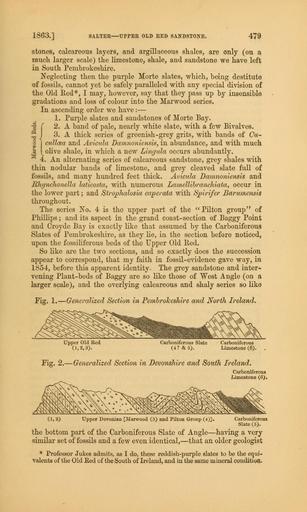MAKE A MEME
View Large Image

| View Original: | The_Quarterly_journal_of_the_Geological_Society_of_London_(12646325234).jpg (1225x2046) | |||
| Download: | Original | Medium | Small | Thumb |
| Courtesy of: | commons.wikimedia.org | More Like This | ||
| Keywords: The Quarterly journal of the Geological Society of London (12646325234).jpg 1863 <br> SALTER UPPER OLD RED SANDSTONE <br> 479 <br> stones calcareous layers and argillaceous shales are only on a <br> much larger scale the limestone shale and sandstone we have left <br> in South Pembrokeshire <br> Neglecting then the purple Morte slates which being destitute <br> of fossils cannot yet be safely paralleled with any special division of <br> the Old Red I may however say that they pass up by insensible <br> gradations and loss of colour into the Marwood series <br> In ascending order we have <br> 1 Purple slates and sandstones of Morte Bay <br> 2 A band of pale nearly white slate with a few Bivalves <br> 3 A thick series of greenish-grey grits with bands of Cu- <br> cullcea and Avicula Damnoniensis in abundance and with much <br> olive shale in which a new Lingida occurs abundantly <br> 1 4 An alternating series of calcareous sandstone grey shales with <br> thin nodular bands of limestone and grey cleaved slate full of <br> fossils and many hundred feet thick Avicula Damnoniensis and <br> Hhynchonella laticosta with numerous Lamellibranchiata occur in <br> the lower part ; and Strophalosia caperata with Spirifer Barumensis <br> throughout <br> The series No 4 is the upper part of the Pilton group of <br> Phillips ; and its aspect in the grand coast- section of Baggy Point <br> and Croyde Bay is exactly like that assumed by the Carboniferous <br> Slates of Pembrokeshire as they lie in the section before noticed <br> upon the fossiliferous beds of the Upper Old Bed <br> So like are the two sections and so exactly does the succession <br> appear to correspond that my faith in fossil-evidence gave way in <br> 1854 before this apparent identity The grey sandstone and inter- <br> vening Plant-beds of Baggy are so like those of West Angle on a <br> larger scale and the overlying calcareous and shaly series so like <br> Fig 1 Generalized Section in Pembrokeshire and North Ireland <br> Upper Old Red <br> 1 2 3 <br> Carboniferous Slate <br> 4 5 <br> Carboniferous <br> Limestone 6 <br> Fig 2 Generalized Section in Devonshire and South Ireland <br> Carboniferous <br> Limestone 6 <br> 1 2 <br> Upper Devonian Marwood 3 and Piltoa Group 4 <br> Carboniferous <br> Slate 5 <br> the bottom part of the Carboniferous Slate of Angle having a very <br> similar set of fossils and a few even identical that an older geologist <br> Professor Jukes admits as I do these reddish-purple slates to be the equi- <br> valents of the Old Red of the South of Ireland and in the same mineral condition 35328466 109632 51125 Page 479 Text v 19 http //www biodiversitylibrary org/page/35328466 1863 Geological Society of London NameFound Avicula NameConfirmed Avicula EOLID 10721231 NameBankID 4633901 NameFound Damnoniensis NameFound Hhynchonella laticosta NameConfirmed Rhynchonella laevicosta NameFound Lamellibranchiata NameConfirmed Lamellibranchiata EOLID 2215 NameBankID 5049506 NameFound Spirifer NameConfirmed Spirifer NameBankID 4349330 NameFound Strophalosia caperata Biodiversity Heritage Library The Quarterly journal of the Geological Society of London v 19 1863 Geology Periodicals Smithsonian Libraries bhl page 35328466 dc identifier http //biodiversitylibrary org/page/35328466 smithsonian libraries Information field Flickr posted date ISOdate 2014-02-20 Check categories 2015 August 26 CC-BY-2 0 BioDivLibrary https //flickr com/photos/61021753 N02/12646325234 2015-08-27 11 51 57 cc-by-2 0 PD-old-70-1923 The Quarterly journal of the Geological Society of London 1863 Photos uploaded from Flickr by FĂŚ using a script | ||||